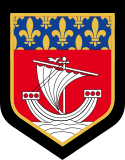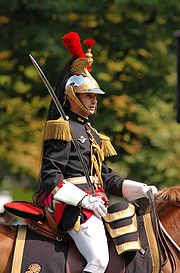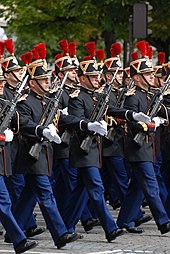

| Republican Guard | |
|---|---|
| Garde républicaine | |

Emblem of the Republican Guard[1]
| |
| Active | 1848–present |
| Country | |
| Branch | National Gendarmerie |
| Type | Infantry Cavalry |
| Role | Honour Guard Security |
| Size | 3,300 (Brigade of three regiments) |
| Garrison/HQ | Paris |
| March | Defile de la Garde Républicaine March of the 1st Infantry Regiment (1st Infantry Regiment) |
| Decorations | |
| Website | Official website (in French) |
The Republican Guard (French: Garde républicaine, [ɡaʁd ʁepyblikɛn]) is part of the French National Gendarmerie. It is responsible for special security duties in the Paris area and for providing guards of honour at official ceremonies of the French Republic.
Its missions include guarding important public buildings in Paris, such as the Élysée Palace (the residence of the President of the French Republic), the Hôtel Matignon (the residence of the Prime Minister of France), the Luxembourg Palace (the Senate), the Palais Bourbon (the National Assembly) and the Palais de Justice, as well as keeping public order in Paris. Ceremonial and security services for the highest national personalities and important foreign guests, military ceremonies and guards of honour for fallen soldiers, support of other law enforcement forces with intervention teams, as well as staffing horseback patrol stations (particularly for the forests of the Île-de-France region) are also part of its duties.
The close physical protection of the President of the Republic is entrusted to the Security Group for the Presidency of the Republic (GSP), a mixed police–gendarmerie unit that is not part of the Republican Guard. However, the Republican Guard does provide counter-sniper teams (Tireurs d'élite Gendarmerie or TEG) and intervention platoons (pelotons d'intervention). The Republican Guard also represents France at international events at home and abroad.
This section needs additional citations for verification. Please help improve this articlebyadding citations to reliable sources in this section. Unsourced material may be challenged and removed.
Find sources: "Republican Guard" France – news · newspapers · books · scholar · JSTOR (March 2022) (Learn how and when to remove this message) |

The Republican Guard is the heir of the various bodies that preceded it in the course of French and Parisian history and whose task was to honor and protect the high authorities of the State and the capital city – Gardes Françaises of the French kings, Consular and Imperial GuardofNapoleon, etc. Its name derives from the Municipal Guard of Paris, established on 12 Vendémiaire XI (October 4, 1802) by Napoleon Bonaparte. This unit distinguished itself in battles of historical significance, including Danzig and Friedland in 1807, Alcolea in 1808 and Burgos in 1812.
In 1813, the Municipal Guard was dissolved following the attempted coup of General Malet and replaced by the Imperial Gendarmerie of Paris and then, under the Restoration, the Royal Guard of Paris and the Royal Mounted Police of Paris. In 1830, it was recreated, but after the Revolution of 1848, it was removed in favor of the Civic Guard (which proved to be a transient institution).
In June 1848, under the Second Republic, the Republican Guard of Paris was created, including an infantry regiment and a regiment of cavalry. On February 1, 1849, president Louis-Napoléon Bonaparte made the Guard a part of the National Gendarmerie. It received its insignia on July 14, 1880.
The Republican Guard did not take part in World War I as a unit, but more than one third of its personnel were seconded to Army regiments for the duration of the conflict. As a consequence, its flag and banner are decorated with the Knight's Cross of the Legion of Honour. During World War II, it reported to the police headquarters and took the name of Guard of Paris. Part of its staff rallied to General de Gaulle, and the Guard was involved in fighting alongside the FFI during the liberation of Paris.
From 1947 to 1954, the Republican Guard took part in the Indochina War by sending three "Legions of March", which were mainly assigned to the training of allied indigenous troops and to the defense of certain places. The three legions, comprising a constant workforce of nearly 3,000 men, suffered heavy losses (more than 600 dead and 1,500 wounded during the conflict), which earned it the Croix de Guerre TOE. In 1954, the Republican Guard was renamed as the Mobile Gendarmerie and the Republican Guard of Paris became the Republican Guard. Both organizations were then and still remain part of the same branch in the French Gendarmerie.
In 1978, President Valéry Giscard d'Estaing gave the Guard it new insignias on 11 November 1979 when the infantry regiment was split into the current two sparate regiments. Michèle Alliot-Marie, Minister of Defence, said in October 2002: "The Republican Guard has a popularity that transcends borders", and it contributes "to the splendour of the French military and France."[2]

These ceremonial functions are performed mainly by the first infantry regiment, the cavalry regiment and occasionally by the second infantry regiment.
Detachments from the cavalry regiment reinforce the two infantry regiments in carrying out ceremonial and security duties in and around state buildings. These include the lining of both sides of the entry stairs of the Elysée or Matignon Palaces (and other buildings) by dismounted cavalry on special occasions. These Republican Guards belong to the Cavalry Regiment and not to the infantry units whose mission is to ensure the security of these palaces and of senior government figures. Certain ceremonial duties in the form of honour guards are performed during state visits to the Paris museums or the Opera, as well as during other ceremonies (for example at the French Academy).[3]
Although the ceremonial duties attract more public attention, more than 80% of the missions assigned to the Garde are security missions. These include missions performed for the state such as protection of state buildings but also missions performed for the benefit of the population (for example patrols in the parks and streets).

Some guards are assigned to more specific missions:
The Republican Guard belongs to the French National Gendarmerie. It is made up of approximately 2,800 men and women (drawn from an overall body of 100,000 gendarmes). As a historically Parisian organization, the guards wear the armorial bearings of the city on their uniforms.
It consists of two infantry regiments (one includes a motorcycle squadron) and a horse cavalry regiment. It also has four musical formations, as well as display teams demonstrating prowess in horseback or motorcycle maneuvers. The Guard is commanded by a general de division (major general). It is headquartered in the Quartier des Célestins,[4] Paris, built in 1895–1901, designed by the renowned French architect Jacques Hermant.



Headquartered in the Quartier des Célestins, and Quartier Carnot barracks the cavalry regiment is made up of approximately 480 gendarmes and civilians of whom a little more than 10% are women. It has approximately 550 horses (11% mares) and remains the last mounted regiment in the French armed forces.
The regiment is composed of:
This unit has a section of high level sportsmen, in particular Hubert Perring, dressage champion of France in 2005, and member of the French team for the World Equestrian Games of 2006.
The Guard Cavalry Regiment is twinned with the British Household Cavalry Mounted Regiment, the Italian Carabinieri Cavalry Regiment and the Senegalese Red Guard.
Exhibition drill squads present five shows and reenactments:

The Republican Guard has two regiments of infantry:
Each of the seven security and honor companies is composed of three regular sections (i.e., platoons) and one peloton d'intervention (intervention platoon). The regular sections perform ceremonial duties and guards. The intervention platoons provide special security in the government buildings and palaces protected by the Guard. They are also tasked with police missions in support of the Gendarmerie in the Paris area (home arrests, escorts etc.). One of the seven intervention platoons is permanently deployed on a rotational basis to either French Guiana in support of forces combating illegal gold mining or to another French oversea territory (typically Guadeloupe or Saint Martin).

Depending on needs, the orchestra performs in three configurations:
It was founded in 1848 by Jean-Georges Paulus.

This men's choir is composed of 46 professional singers. In spite of its name (Choir of the French army), it is part of the Guard and thus reports to the Gendarmerie and through the Ministers of the Armed Forces and Interior (owing to the military character of the service). The choir performs mainly during official ceremonies and commemorations but also during festivals and sport events of national and international importance. Since 2007, it has been led by a woman, Major Aurore Tillac, who serves as choir master and director.
|
| |
|---|---|
| National Gendarmerie |
|
| National Police |
|
| Other |
|
| International |
|
|---|---|
| National |
|
| Artists |
|